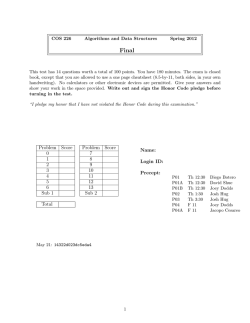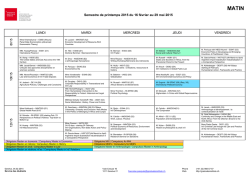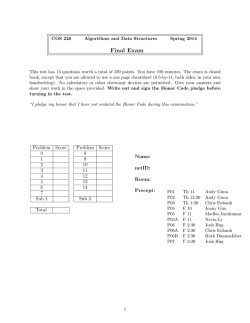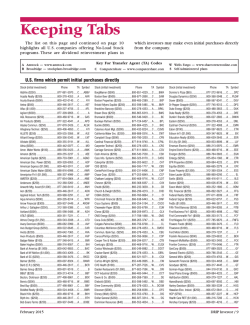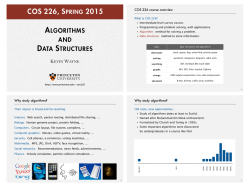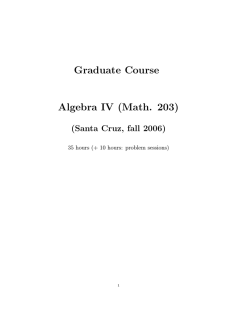
Some Decompositions of πg-Continuity
J f Mathe ma al o nte • I d its Applic rnation An Volume 3, Issue 1 (2015), 149–154. on 57 i ISSN: 2347 -1 s • 5 πg at ISSN: 2347-1557 Some Decompositions of ti al rn cs International Journal of Mathematics And its Applications ou -Continuity O.Ravi†,1 , A.Pandi‡ , R.Senthil Kumar§ and A.Muthulakshmi∗ † Department of Mathematics, P.M.Thevar College, Usilampatti, Madurai, TamilNadu, India. ‡ Department of Mathematics, The Madura College, Madurai, Tamil Nadu, India. § ∗ R. V. S College of Engineering and Technology, Dindugul, Tamil Nadu, India. Department of Mathematics, Yadava College, Tiruppalai, Madurai, Tamil Nadu, India. Abstract : In this paper, we introduce the notions of Er -sets and Er∗ -sets in topological spaces and investigate some of their properties and using these notions we obtain three decompositions of πg-continuity. Keywords : πgα-continuity, πgp-continuity, Er -continuity, Er∗ -continuity and πg-continuity. AMS Subject Classification: 54C08. 1 Introduction and Preliminaries In 1968, Zaitsev [15] introduced the concept of π-closed sets and in 1970, Levine [7] initiated the study of so called g-closed sets in topological spaces. The concept of g-continuity was introduced and studied by Balachandran et. al. in 1991 [3]. Dontchev and Noiri [4] defined the notions of πg-closed sets and πg-continuity in topological spaces. In 1993, Palaniappan and Rao [10] introduced the notions of regular generalized closed (rg-closed) sets and rg-continuity in topological spaces. In 2000, Sundaram and Rajamani [13] obtained three different decompositions of rg-continuity by providing two types of weaker forms of continuity, namely Cr -continuity and Cr∗ -continuity. In this paper, we introduce the notions of Er -sets and Er∗ -sets to obtain three decompositions of πg-continuity by providing two types of weaker forms of continuity, namely Er -continuity and Er∗ -continuity. Let (X, τ ) be a topological space and also cl(A) and int(A) denote the closure of A and the interior of A in (X, τ ), respectively. Definition 1.1. A subset A of (X, τ ) is said to be (i) α-open [9] if A ⊆ int(cl(int(A))), (ii) preopen [8] if A ⊆ int(cl(A)), (iii) regular open [12] if A = int(cl(A)), 1 Corresponding author E-Mail: [email protected] (O.Ravi) 150 Int. J. Math. And its App. Vol.3 No.1 (2015)/ O.Ravi, A.Pandi, R.Senthil Kumar and A.Muthulakshmi (iv) π-open [15] if the finite union of regular open sets, (v) πg-open [4] iff F ⊆ int(A) whenever F ⊆ A and F is π-closed in (X, τ ), (vi) πgp-open [11] iff F ⊆ pint(A) whenever F ⊆ A and F is π-closed in (X, τ ), (vii) πgα-open [2] iff F ⊆ αint(A) whenever F ⊆ A and F is π-closed in (X, τ ), (viii) a t-set [14] if int(A) = int(cl(A)), (ix) an α∗ -set [5] if int(A) = int(cl(int(A))). The complements of the above mentioned open sets are called their respective closed sets. The preinterior pint(A) (resp. α-interior, αint(A)) of A is the union of all preopen sets (resp. α-open sets) contained in A. The α-closure αcl(A) of A is the intersection of all α-closed sets containing A. Lemma 1.2 ([1]). If A is a subset of X, then (i) pint(A) = A ∩ int(cl(A)), (ii) αint(A) = A ∩ int(cl(int(A))) and αcl(A) = A ∪ cl(int(cl(A))). Remark 1.3. The following hold in a topological space. (i) Every πg-open set is πgp-open but not conversely [11]. (ii) Every πg-open set is πgα-open but not conversely [2]. 2 πgα-open Sets Proposition 2.1. For a subset of a topological space, the following hold: Every πgα-open set is πgp-open. Proof. It follows from the definitions. Remark 2.2. The converse of Proposition 2.1 is not true, in general. Example 2.3. Let X= {a, b, c, d, e} and τ = {φ, {a}, {e}, {a, e}, {c, d}, {a, c, d}, {c, d, e}, {a, c, d, e}, {b, c, d, e}, X}. Then {b, c, e} is πgp-open set but not πgα-open. Remark 2.4. By Proposition 2.1 and Remark 1.3, we have the following diagram. In this diagram, there is no implication which is reversible as shown by examples above. πg-open . ↓ πgα-open & πgp-open Some Decompositions of πg-Continuity 3 151 Er -sets and Er∗ -sets Definition 3.1. A subset A of a topological space (X, τ ) is called (i) a Er -set if A = U ∩ V, where U is πg-open and V is a t-set, (ii) a Er∗ -set if A = U ∩ V, where U is πg-open and V is an α∗ -set. We have the following proposition: Proposition 3.2. For a subset of a topological space, the following hold: (i) Every t-set is an α∗ -set [5] and a Er -set. (ii) Every α∗ -set is a Er∗ -set. (iii) Every Er -set is a Er∗ -set. (iv) Every πg-open set is a Er -set. From Proposition 3.2, We have the following diagram. πg-open set −→ Er -set ←− t-set ↓ Er∗ -set ↓ ←− ∗ α -set Remark 3.3. The converses of implications in Diagram II need not be true as the following examples show. Example 3.4. Let X= {a, b, c, d, e} and τ = {φ, {a}, {e}, {a, e}, {c, d}, {a, c, d}, {c, d, e}, {a, c, d, e}, {b, c, d, e}, X}. Then {b} is Er -set but not πg-open. Example 3.5. In Example 3.4, {c} is Er -set but not t-set. Example 3.6. In Example 3.4, {b, c} is Er∗ -set but not Er -set. Example 3.7. In Example 3.4, {c} is α∗ -set but not t-set. Example 3.8. In Example 3.4, {c, d, e} is Er∗ -set but not α∗ -set. Proposition 3.9. A subset A of X is πg-open if and only if it is both πgp-open and a Er -set in X. Proof. Necessity is trivial. We prove the sufficiency. Assume that A is πgp-open and a Er -set in X. Let F ⊆ A and F is π-closed in X. Since A is a Er -set in X, A = U ∩ V , where U is πg-open and V is a t-set. Since A is πgp-open, F ⊆ pint(A) = A ∩ int(cl(A)) = (U ∩ V ) ∩ int(cl(U ∩ V )) ⊆ (U ∩ V ) ∩ int(cl(U )∩ cl(V )) = (U ∩ V ) ∩ int(cl(U )) ∩ int(cl(V )). This implies F ⊆ int(cl(V )) = int(V ) since V is a t-set. Since F is π-closed, U is πg-open and F ⊆ U , we have F ⊆ int(U ). Therefore, F ⊆ int(U ) ∩ int(V ) = int(U ∩ V ) = int(A). Hence A is πg-open in X. Corollary 3.10. A subset A of X is πg-open if and only if it is both πgα-open and a Er -set in X. Proof. This is an immediate consequence of Proposition 3.9. 152 Int. J. Math. And its App. Vol.3 No.1 (2015)/ O.Ravi, A.Pandi, R.Senthil Kumar and A.Muthulakshmi Proposition 3.11. A subset A of X is πg-open if and only if it is both πgα-open and a Er∗ -set in X. Proof. Necessity is trivial. We prove the sufficiency. Assume that A is πgα-open and a Er∗ -set in X. Let F ⊆ A and F is π-closed in X. Since A is a Er∗ -set in X, A = U ∩ V , where U is πg-open and V is an α∗ -set. Now since F is π-closed, F ⊆ U and U is πg-open, F ⊆ int(U). Since A is πgα-open, F ⊆ αint(A) = A ∩ int(cl(int(A))) = (U ∩ V ) ∩ int(cl(int(U ∩ V ))) = (U ∩ V ) ∩ int(cl(int(U ) ∩ int(V ))) ⊆ (U ∩ V ) ∩ int(cl(int(U )) ∩ cl(int(V ))) = (U ∩ V ) ∩ int(cl(int(U ))) ∩ int(cl(int(V ))) = (U ∩ V ) ∩ int(cl(int(U ))) ∩ int(V ), since V is an α∗ -set. This implies F ⊆ int(V ). Therefore, F ⊆ int(U ) ∩ int(V ) = int(U ∩ V ) = int(A). Hence A is πg-open in X. Remark 3.12. (i) The concepts of πgp-open sets and Er -sets are independent of each other. (ii) The concepts of πgα-open sets and Er -sets are independent of each other. (iii) The concepts of πgα-open sets and Er∗ -sets are independent of each other. Example 3.13. Let X= {a, b, c, d, e} and τ = {φ, {a}, {e}, {a, e}, {c, d}, {a, c, d}, {c, d, e}, {a, c, d, e}, {b, c, d, e}, X}. Then {b, c, e} is πgp-open but not Er -set and {b, e} is Er -set but not πgp-open. Example 3.14. Let X = {a, b, c, d} and τ = {φ, X, {a}, {b}, {a, b}, {b, c}, {a, b, c}}. Then {a, d} is Er -set but not πgα-open set. Also {a, b, d} is an πgα-open set but not Er -set. Example 3.15. In Example 3.14, {a, d} is Er∗ -set but not πgα-open set and {a, b, d} is an πgα-open set but not Er∗ -set. 4 Decompositions of πg-continuity Definition 4.1. A mapping f : (X, τ ) → (Y, σ) is said to be πg-continuous [4] (resp. πgp-continuous [11], πgα-continuous [2], Er -continuous and Er∗ -continuous) if f−1 (V) is πg-open (resp. πgp-open, πgαopen, Er -set and Er∗ -set) in (X, τ ) for every open set V in (Y, σ). From Propositions 3.9 and 3.11 and Corollary 3.10 we have the following decompositions of πgcontinuity. Theorem 4.2. For a mapping f : (X, τ ) → (Y, σ), the following properties are equivalent: (i) f is πg-continuous; (ii) f is πgp-continuous and Er -continuous; (iii) f is πgα-continuous and Er -continuous; (iv) f is πgα-continuous and Er∗ -continuous. Remark 4.3. (i) The concepts of πgp-continuity and Er -continuity are independent of each other. (ii) The concepts of πgα-continuity and Er -continuity are independent of each other. Some Decompositions of πg-Continuity 153 (iii) The concepts of πgα-continuity and Er∗ -continuity are independent of each other. Example 4.4. (i) Let X = Y = {a, b, c, d, e}, τ = {φ, {a}, {e}, {a, e}, {c, d}, {a, c, d}, {c, d, e}, {a, c, d, e}, {b, c, d, e}, X} and σ = {φ, {b, c, e}, Y}. Let f : (X, τ ) → (Y, σ) be the identity function. Then f is πgp-continuous but not Er -continuous. (ii) Let X = Y = {a, b, c, d, e}, τ = {φ, {a}, {e}, {a, e}, {c, d}, {a, c, d}, {c, d, e}, {a, c, d, e}, {b, c, d, e}, X} and σ = {φ, {a, b}, Y}. Let f : (X, τ ) → (Y, σ) be the identity function. Then f is Er -continuous but not πgp-continuous. Example 4.5. (i) Let X = Y = {a, b, c, d}, τ = {φ, X, {a}, {b}, {a, b}, {b, c}, {a, b, c}} and σ = {φ, {a, d}, Y}. Let f : (X, τ ) → (Y, σ) be the identity function. Then f is Er -continuous but not πgα-continuous. (ii) Let X = Y = {a, b, c, d}, τ = {φ, X, {a}, {b}, {a, b}, {b, c}, {a, b, c}} and σ = {φ, {a, b, d}, Y}. Let f : (X, τ ) → (Y, σ) be the identity function. Then f is πgα-continuous but not Er -continuous. Example 4.6. (i) Let X = Y = {a, b, c, d}, τ = {φ, X, {a}, {b}, {a, b}, {b, c}, {a, b, c}} and σ = {φ, {a, d}, Y}. Let f : (X, τ ) → (Y, σ) be the identity function. Then f is Er∗ -continuous but not πgα-continuous. (ii) Let X = Y = {a, b, c, d}, τ = {φ, X, {a}, {b}, {a, b}, {b, c}, {a, b, c}} and σ = {φ, {a, b, d}, Y}. Let f : (X, τ ) → (Y, σ) be the identity function. Then f is πgα-continuous but not Er∗ -continuous. References [1] D.Andrijevic, Semi-preopen sets, Mat. Vesnik, 38(1)(1986), 24-32. [2] I.Arockiarani, K.Balachandran and C.Janaki, On contra-πgα-continuous functions, Kochi J. Math., 3(2008), 201-209. [3] K.Balachandran, P.Sundaram and H.Maki, On generalized continuous maps in topological spaces, Mem. Fac. Sci. Kochi Univ. Ser. A. Math., 12(1991), 5-13. [4] J.Dontchev and T.Noiri, Quasi-normal spaces and πg-closed sets, Acta Math. Hungar., 89(3)(2000), 211-219. [5] E.Hatir, T.Noiri and S.Yuksel, A decomposition of continuity, Acta Math. Hungar., 70(1996), 145150. [6] N.Levine, A decomposition of continuity in topological spaces, Amer. Math. Monthly, 68(1961), 44-46. [7] N.Levine, Generalized closed sets in topology, Rend. Circ. Mat. Palermo, 19(2)(1970), 89-96. [8] A.S.Mashhour, M.E.Abd El-Monsef and S.N.El-Deeb, On precontinuous and weak precontinuous mappings, Proc. Math. Phys. Soc. Egypt, 53(1982), 47-53. 154 Int. J. Math. And its App. Vol.3 No.1 (2015)/ O.Ravi, A.Pandi, R.Senthil Kumar and A.Muthulakshmi [9] O.Njastad, On some classes of nearly open sets, Pacific J. Math., 15(1965), 961-970. [10] N.Palaniappan and K.C.Rao, Regular generalized closed sets, Kyungpook Math. J., 33(1993), 211219. [11] J.H.Park, On πgp-closed sets in topological spaces, Indian J. Pure Appl. Math., to appear. [12] M.H.Stone, Applications of the theory of Boolean rings to general topology, Trans. Amer. Math. Soc., 41(1937), 375-481. [13] P.Sundaram and M.Rajamani, Some decompositions of regular generalized continuous maps in topological spaces, Far East J. Math. Sci., II(2000), 179-188. [14] J.Tong, On decomposition of continuity in topological spaces, Acta Math. Hungar., 54(1989), 51-55. [15] V.Zaitsev, On certain classes of topological spaces and their bicompactifications, Dokl. Akad. Nauk. SSSR, 178(1968), 778-779.
© Copyright 2025
